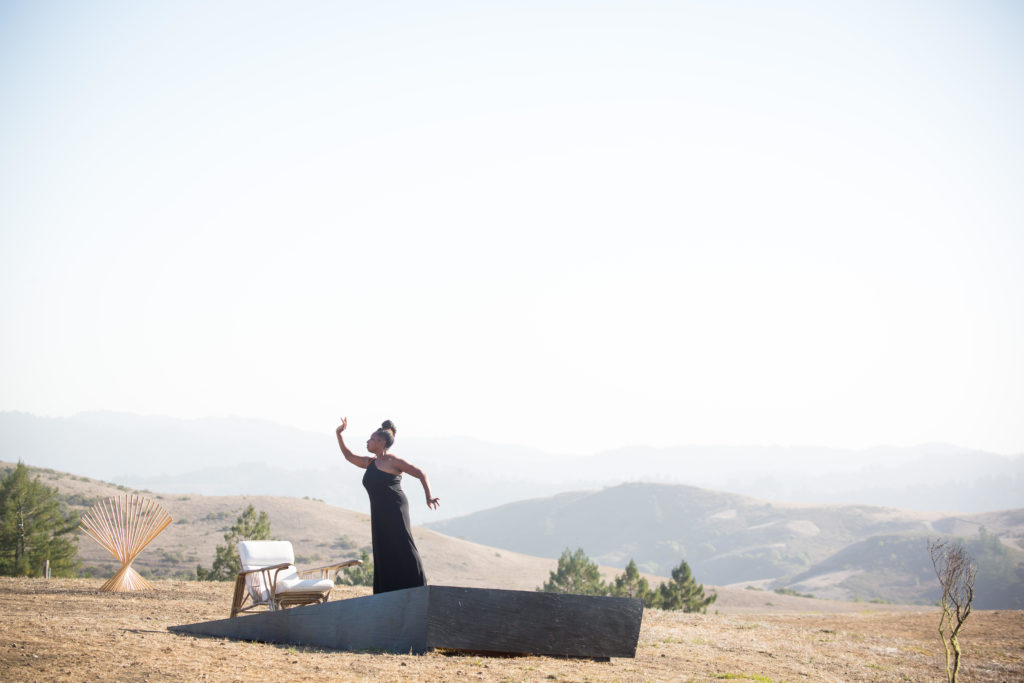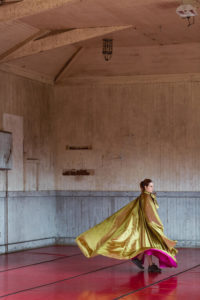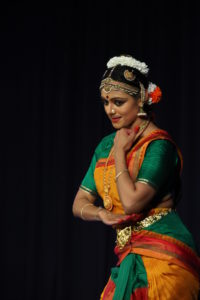
Djerassi Resident Artists Program
Photo by Colson Griffith
Inspiration pours from your graceful fingertips and toes. If only you had time and space to explore the depths of your imagination freely, validating what you already know to be true: that you are a dancemaker and you must create.
‘Tis no fantasy. There is in fact a way to hone your skills, develop and present your work – as you so desire, and it doesn’t have to cost you a cent.
Artist in Residence (AIR) programs that cater to dance are distinctly designed for dancemakers. While some focus on research-and-development, others are performance or teaching-based. Long-term residencies are typically planned a year in advance or more.
The advantages are many. AIR opportunities are available to both emerging and established artists – whether local, from out of state, or abroad. One residency experience can lead to others. An artist can even make a career out of participating in artist residency programs if they so desire. However, a tremendous amount of research goes into finding the right programs. The application submission process is no less daunting.
The most sought-after residencies offer fully subsidized accommodations and creative time, space, and support including food allowances and housing, enabling artists to focus on their creativity. Artists are competitively selected for these residencies which can span anywhere from one week to several years. Many artist communities can support a single artistic discipline or bring together artists of other disciplines.
Settings vary anywhere from rural hideaways to urban warehouses. According to the Alliance of Artists Communities about 60% are in rural or small-town environments.
Established in 1991, The Alliance of Artists Communities is an international association of artist residency programs that provides artists of all disciplines time and space for the creation of new work.
During the alliance’s formation, the MacArthur Foundation—the funding source behind the creation of the Alliance of Artists Communities, and advocate in favor of nurturing the creative process—selected 18 organizations for a one-time $2.5 million, subsidized initiative focused on Artists’ Colonies, Communities, and Residencies. Organizations partaking in the initiative included the Djerassi Resident Artists Program, Headlands Center for the Arts, and Jacob’s Pillow among others.
Important to note is the Alliance of Artists Communities’ “Mind the Gap” study published in 2011, an extensive survey of dance residency programs. The study was conducted following a 2008 report by the National Endowment for the Arts, bringing to light how “Dancemakers are under-served and under-resourced, even as compared to other artists.”
Advancement Director Terra Fuller of the Djerassi Resident Artist Program responds, “We are closely affiliated with the Alliance of Artist Communities. We are familiar with the “Mind the Gap” study and are proud to be among the 14% of residencies with dance studios, which is a statistic listed in that study.” Fuller acknowledges the shortcomings that exist in dance residencies. “Studio space dictates the number of choreographers in residence. At Djerassi, we have one dance resident each session (two if they bring a collaborator), whereas we can accommodate 6-7 writers and 3 visual artists per session.”
The alliance’s website, ArtistCommunities.org states there are over 160 dance residency programs in the U.S. and Canada and dozens more around the world. The website serves as a free, comprehensive online source connecting artists with residency programs everywhere. Resources include a residency directory with tips on: how to apply; how to create a residency; how to crowdfund; and also lists annual conferences and workshops happening around the country.
While the Alliance of Artists Residencies serves international artists of all disciplines worldwide, dance residencies in the Bay Area vicinity are somewhat plentiful compared to other parts of the country.
Artistic and executive director Julie Phelps of CounterPulse in San Francisco says, “Dance continues to be the most marginalized performing art form. If I were to take a guess it’s because art’s history traced industrial development, and as the body became more and more suppressed as labor standard became harder on the body, dance went into the shadow. Not to mention Victorian and Puritan moralistic body shaming.”
Phelps advocates that dance residencies should include: “sprung dance floors, adequate space, producing support to fully and professionally realize staged work, more grants geared toward dance.”
Residency applicants at CounterPulse are primarily comprised of up-and-coming dancers and choreographers, along with a few dance company ensembles. In most cases, applicants have completed one or more residencies elsewhere.

Communications and engagement manager Justin Ebrahemi shares, “CounterPulse does not have an application fee. We want to ensure our residency programs are as accessible as possible while offering a generous artist stipend to participating artists. We do however ask applicants to become CounterPulse members (we have a pay-what-you-can membership program) as we see our residency programs as a mutual agreement to support each other’s visions. All of our [four] residency programs include outreach and mentorship opportunities to our artists, including progress showings, discourse events, and publishing creative content about their work.”
Recognized as one of the world’s foremost artist residencies, the Djerassi residency program receives a combination of emerging, mid-career, as well as some established dancers and choreographers which have included Deborah Slater, Dohee Lee, Sara Shelton Mann, Derrick Jones, Weidong Yang, and Jodi Lomask.
Djerassi has a large dance studio with a sprung floor and offers overnight accommodations for dancers or videographers who collaborate with choreographers. Fuller proudly shares, “A Djerassi residency is fee-free to the artist; yet each 30-day residency costs the program about $10,000. The diversity of residency models makes a rich and strong field, but we are committed to remaining fee-free to artists.”
Fuller continues, “All artists arrive and leave at the same time, creating intense interdisciplinary cohorts. Another distinct opportunity for choreography and dance artists at Djerassi is the collegial interaction with artists of other disciplines. A quote from a painter, Paula Bullwinkel, from Bend, Oregon, illustrates the value of the cross-disciplinary experiences. She wrote, ‘Bonding with other artists at Djerassi was phenomenal. We had so much in common. When the writers gave feedback to one of the residents at a reading, I realized their ideas applied to visual concepts. When one of the dancers talked about moving instinctively versus choreographed moves, I saw how that concept could apply to painting as well. I began to experiment with mixing realism with expressionism.’ ”
Residencies for mostly mid-career and established artists at the Marin based Headlands Center for the Arts offer a unique model as well. Uyehara explains, “By providing the five key supports that artists need—namely time, space, money, validation, and networks—at a site ideally situated to foster introspection and exchange, we nurture original thought and spark vital new directions in art. Our vision is to provide the ideal conditions for artists and creative thinkers to develop new works and ideas, no matter their discipline. We provide: A private bedroom in a shared historic home, chef-prepared meals five nights a week, a stipend, round-trip travel to the site, opportunities to participate in public programs and open studios, connection to a wide network in the arts, including Headlands artists, both current and alumni. Performance facilities consist of a stand-alone studio in Headlands’ iconic gym or a redwood-lined former warehouse. Artists also have access to the campus at large, with a variety of historic spaces.”
To ensure residency programs at Headlands continue, consistent monetary backing remains a vital component. Uyehara says, “For Headlands and across the field, we need to see institutional and public support in the forms of financial contributions, public program attendance, and people and organizations voicing interest in the institutional support of dance production.”

SAFEhouse Arts (Saving Arts from Extinction) in San Francisco offers emerging and mid-career artist residencies focused on contemporary dance. Resident Artist Workshops (RAW) provide artists with rehearsal space, mentorship, marketing, and production support for performance. Residencies are dedicated to supporting queer and trans artists of color and people living with HIV/AIDS, and the RAW Lead Artist Program is designed for artists seeking a long-term artistic relationship with SAFEhouse.
Executive director and founder of SAFEhouse for the Performing Arts, Joe Landini says, “We accept the majority of artists that apply and most artists can stay for any period of time they want. Last year we supported 135 residencies. We don’t charge an application fee. Our program is completely free. I think that if there is value, then paying for a residency is fine. Each artist has to examine the program and decide if it’s a good fit for them.”
Words of wisdom to artists pursuing dance residencies:
“We [CounterPulse] recommend that interested applicants express interest in promoting their work and engaging with new/current audiences throughout their residencies. Also, get involved and familiar with CounterPulse. Come to shows, come to open call info sessions, get to know our community,” says Ebrahemi.
Uyehara with Headlands says, “Capture compelling documentation of your work. Apply with a thoughtful articulation of your practice. And don’t wait until the last minute to finish those applications. If possible, come to Headlands to see the facilities.”
Fuller with Djerassi says, “Don’t be discouraged if you don’t get accepted – keep trying. The selection panels rotate every year. Each year we have about 900 applications for 70 residency spots.”
Landini with SAFEhouse says, “Each program has its own set of criteria, for example, ours is not very process orientated, it’s very much about generating public performance. Other programs are more about process and investigating.”
You’re a dancemaker and you deserve an audience. Residency administrators are ready to receive your letter of interest and learn about your unique aesthetic. Now that you have the right skill set and tools, take the next step. Leap toward your future and begin now.
This article appeared in the September 2018 edition of In Dance.
Artist in Residency Opportunities: A Short-List
Those looking for a residency program may start their search with Alliance of Artist Communities (artistcommunities.org), Culture and Creativity (culturepartnertship.eu), or Res Artis (resartis.org/en) – all aggregate information about opportunities for all artistic disciplines and around the world.
Below is a selection of local and national residencies that are open to dance-makers.
San Francisco Bay Area
Brava! for Women in the Arts, SF
Supporting the artistic expression of women, people of color, LGBTQIA with space, technical and admin support. brava.org
Chalk Hill Artist Residency, Sonoma
For established, emerging, and “outsider” artists at the historic Warnecke Ranch & Vineyards.
chalkhillresidency.com
CounterPulse, SF
Four programs for emerging artists and cultural innovators, serving as an incubator for the creation of socially relevant, community-based art and culture. counterpulse.org
Djerassi Resident Artists Program, Woodside
Six residency sessions each year, with one dedicated to the intersection of art and science. djerassi.org
Headlands Center for the Arts, Sausalito
10-week residencies for individuals at the cutting edge of their fields. headlands.org
Lucid Art Foundation, Inverness
Three week residencies with special emphasis on the integration of art, process, and inner awareness. lucidart.org
ODC Theater, SF
A three-year program. Next available residencies begin in 2021. odc.dance
SAFEhouse Arts, SF
Focused on emerging artists in dance, experimental theatre and interdisciplinary performance. safehousearts.org
Shawl-Anderson Dance Center, Berkeley
For emerging and established local artists, without expectations to produce a performance. shawl-anderson.org
Zaccho Dance Theatre, SF
Discounted studio and performance space to resident companies considered innovators in the field of contemporary and aerial dance. zaccho.org
National
Atlantic Center for the Arts, New Smyrna Beach, FL
A three week Program brings together three “Master Artists” from different disciplines. atlanticcenterforthearts.org
Bemis Center for Contemporary Arts, Omaha, NE
Offers private live/work studios, financial support, technical/administrative assistance, and free public programs. bemiscenter.org
Downtown Dance Collective, Missoula
Supporting collaborative, original work culminating in a performance. ddcmontana.com
Jacob’s Pillow, Becket, MA
The In Process Series support research and develop of new work. jacobspillow.org
National Park Service: Arts in the Parks
Residencies for artists at parks across the nation, each with their own unique programming. nps.gov
Residency Unlimited, New York
Customized residency environments for artists at all stages of practice. residencyunlimited.org
The Yard, Chillmark, MA
Residency programs emphasize collaborative process in contemporary dance, devised theater and music. dancetheyard.org
Velocity Dance Center, Seattle
For dance and movement-based artists to develop performances, interactive events, and installations. velocitydancecenter.org
Yaddo, Saratoga Springs
200 artists from all disciplines are served by Yaddo’s process-focused residencies annually.
yaddo.org


